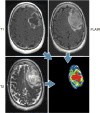Unravelling tumour heterogeneity using next-generation imaging: radiomics, radiogenomics, and habitat imaging
- PMID: 27742105
- PMCID: PMC5503113
- DOI: 10.1016/j.crad.2016.09.013
Unravelling tumour heterogeneity using next-generation imaging: radiomics, radiogenomics, and habitat imaging
Abstract
Tumour heterogeneity in cancers has been observed at the histological and genetic levels, and increased levels of intra-tumour genetic heterogeneity have been reported to be associated with adverse clinical outcomes. This review provides an overview of radiomics, radiogenomics, and habitat imaging, and examines the use of these newly emergent fields in assessing tumour heterogeneity and its implications. It reviews the potential value of radiomics and radiogenomics in assisting in the diagnosis of cancer disease and determining cancer aggressiveness. This review discusses how radiogenomic analysis can be further used to guide treatment therapy for individual tumours by predicting drug response and potential therapy resistance and examines its role in developing radiomics as biomarkers of oncological outcomes. Lastly, it provides an overview of the obstacles in these emergent fields today including reproducibility, need for validation, imaging analysis standardisation, data sharing and clinical translatability and offers potential solutions to these challenges towards the realisation of precision oncology.
Crown Copyright © 2016. Published by Elsevier Ltd. All rights reserved.
Figures



References
-
- Yamamoto S, Maki DD, Korn RL, Kuo MD. Radiogenomic analysis of breast cancer using MRI: a preliminary study to define the landscape. AJR Am J Roentgenol. 2012;199(3):654–63. - PubMed
Publication types
MeSH terms
Substances
Grants and funding
LinkOut - more resources
Full Text Sources
Other Literature Sources
Medical

